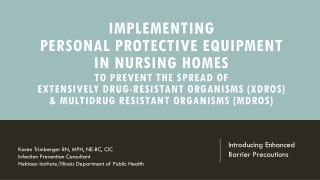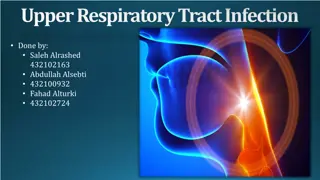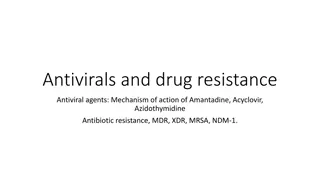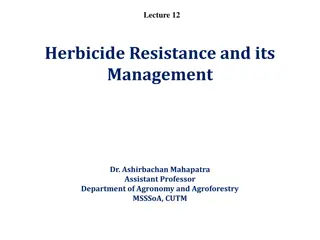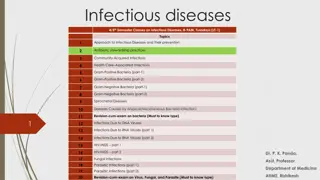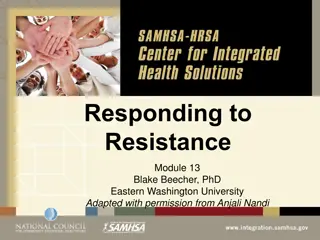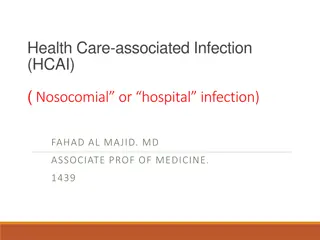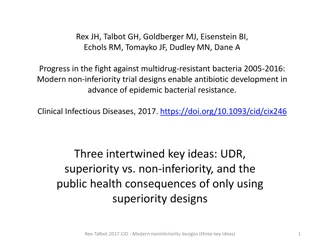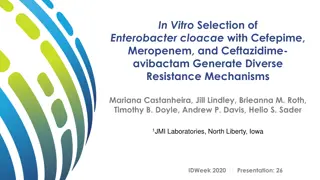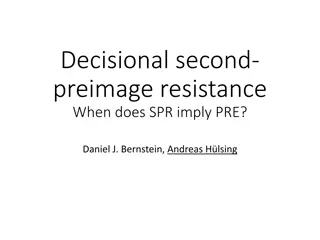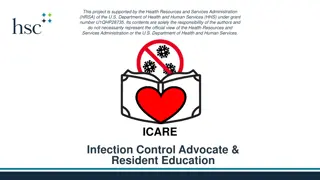Understanding Multidrug Resistance in Bacterial Infections
Multidrug resistance refers to organisms resistant to multiple antibiotics, impacting therapy decisions, increasing morbidity and mortality, and raising healthcare costs. Monitoring resistance profiles can aid in tracking outbreaks, with molecular typing confirming issues. Join the WHONET Webinar Series for insights on defining multidrug resistance and utilizing antibiograms for surveillance.
Download Presentation

Please find below an Image/Link to download the presentation.
The content on the website is provided AS IS for your information and personal use only. It may not be sold, licensed, or shared on other websites without obtaining consent from the author. Download presentation by click this link. If you encounter any issues during the download, it is possible that the publisher has removed the file from their server.
E N D
Presentation Transcript
WHONET and Multidrug resistance John Stelling, MD, MPH, jstelling@whonet.org Brigham and Women s Hospital, Harvard Medical School, Boston WHO Collaborating Centre for Surveillance of Antimicrobial Resistance
Webinar agenda Comments on the WHONET Webinar series Clinical and public health importance Approaches for defining multidrug resistance WHONET analyses Antibiograms using resistance filters Scatterplots Resistance profiles Outbreak detection Resistance phenotype and genotype correlation
WHONET Webinar series Past webinars September WHONET and WHO GLASS 2.0 October WHONET macros and reports Today s webinar November WHONET and multidrug resistance The next webinar will be in January Possible ideas for future webinars Annual antibiograms and CLSI M39 Isolate alerts and outbreak detection with WHONET-SaTScan WHONET DHIS2-AMR module WHONET Automation Tool WHONET AST interpretation engine WHONET Discussion Forum One Health features of WHONET FAO and InFARM Country-, region-, and/or language-specific sessions Welcome to suggest ideas for future webinars! help@whonet.org
WHONET Webinar Series You can find the recording, slides, and additional resources on the WHONET website by clicking on Webinars on the main menu. Or you can use the direct link: https://whonet.org/webinars.html We have translated our previous webinar into 18 additional languages which are available through the closed caption settings of the video on YouTube: https://www.youtube.com/watch?v=sJNjO0TQcwA Click on CC to turn Closed Captions on and off. Use the Configuration icon to choose the desired language. Afrikaans, Arabic, Chinese (Simplified and Traditional), Farsi, French, German, Indonesian, Japanese, Korean, Lao, Malay, Portuguese, Russian, Spanish, Turkish, Ukrainian, Vietnamese. Demonstration of the WHONET Webinar website
Multidrug resistance When an organism is resistant to several antibiotics, then we describe it as multidrug resistant . However, a variety of definitions have been proposed over time for different organisms and for different purposes. Clinical consequences: There are impacts on therapy decisions for individual patients, for treatment guidelines, and for formulary decisions. Increased morbidity and mortality Increased healthcare costs because of documented MDR Increased healthcare costs because of the concern about possible MDR Increased use of agents with higher toxicities (aminoglycosides, chloramphenicol) Epidemiological insights: Monitoring multidrug resistance profiles can be utilized for recognizing and tracking phenotypic clones . Phenotypic monitoring is valuable for recognizing new strains and for the detection of possible community and hospital outbreaks Phenotypes do not provide the same level of detail as genotypes, but the results are low cost and routinely available. Molecular typing can be performed to confirm problems suggested by the phenotypes.
Morbidity and mortality due to MDR In the absence of antibiotic treatment, one would generally expect the morbidity and mortality associated with infections due to resistant bacteria and due to susceptible bacteria to be similar. The primary difference between infections due to susceptible bacteria and resistant bacteria is in the availability and cost of effective treatment options, not in pathogenicity Morbidity and mortality are higher in resistant infections because of the use of ineffective antibiotics, either because of: 1) lack of diagnostic testing or; 2) lack of access to effective agents. Examples: Mycobacterium tuberculosis, Neisseria gonorrhoeae, Escherichia coli, Acinetobacter baumannii However, there is an increasing number of examples where multidrug-resistant bacteria are also more virulent and transmissible than susceptible bacteria. Virulence factors are also determined by genetic elements that can be transferred on plasmids and pathogenicity islands, and these can be linked to resistance genes. The consequence is a rise in organisms that are both more virulent and more difficult to treat. Examples include MRSA, Escherichia coli ST131, and Salmonella Typhimurium DT104
Conceptual difference between single-drug resistance, multi-drug resistance, and pan-drug resistance The microbiology laboratory can guide you in selecting an effective drug. Susceptible strains can be treated with any antibiotic generally recognized as effective for the infection. With single drug resistance, most antibiotics would work except for one. Antimicrobial susceptibility testing (AST) can indicate which drug to avoid. With multi-drug resistance, AST takes on increasing importance to determine which drugs would and would not work. The microbiology laboratory can only confirm the problem there is no effective drug available. With resistance to all locally available drugs, AST can only provide confirmation. It is important to work with pharmacies and drug procurers to ensure the availability of effective agents, perhaps expanding the essential drugs list. With resistance to all commercially available drugs, AST can only provide confirmation. This is a major challenge for the pharmaceutical industry.
Definitions of Multidrug resistance Over the years, a number of definitions for multidrug resistance have been proposed. Some have been well-standardized and accepted in the international literature Mycobacterium tuberculosis: MDR TB = Multidrug-resistant TB = Resistant to at least isoniazid and rifampin XDR TB = Extensively drug-resistant TB = Resistant to isoniazid, rifampin, a fluroquinolone, and a second-line injectable (amikacin, capreomycin, and kanamycin) OR Resistant to isoniazid, rifampin, a fluroquinolone, and bedaquiline or linezolid (CDC definition) Neisseria gonorrhoeae MDR = resistant to one of the category I antibiotics (injectable extended spectrum cephalosporins, oral extended-spectrum cephalosporins, and spectinomycin) and at least two of the category II antibiotic classes (penicillins, fluoroquinolones, azithromycin, aminoglycosides and carbapenems) XDR: resistant to two or more of the antibiotic classes in category I and three or more in category II Salmonella spp. Resistance profiles are often presented with results from AMP, CHL, STR, SUL, TCY (ACSSuT) ACCSuT + Fluoroquinolone Routine bacterial pathogens: 2012 paper from Magiorakis et al. led by the ECDC with proposed definitions for MDR, XDR, and PDR
MDR/XDR/PDR definitions from 2012 paper Magiorakis et al. Multidrug-resistant, extensively drug-resistant and pandrug-resistant bacteria: an international expert proposal for interim standard definitions for acquired resistance, Clin Microbiol Infect 2012 Mar; 18(3):268-81. Organisms included: Staphylococcus aureus, Enterococcus spp., Enterobacteriaceae, Pseudomonas aeruginosa, and Acinetobacter spp. Definitions MDR: Non-susceptible to at least 1 agent in 3 antimicrobial categories in the relevant table XDR: Non-susceptible to at least 1 agent in all but 2 or fewer antimicrobial categories in the table PDR: Non-susceptible to all agents in all antimicrobial categories in the table Some problems with the ECDC definitions The testing recommendations for XDR and PDR are not practical for routine clinical laboratories Possible XDR and Possible PDR There is no clear correlation between MDR/XDR/PDR category and treatment outcomes Possible update to 2012 paper: Working group of the EU-US Transatlantic Taskforce on Antimicrobial Resistance (TATFAR) Note There is an incorrect comment in the definition of XDR, which has been confirmed by ECDC staff. PDR is a subset of XDR, which is a subset of MDR.
Newer proposals for monitoring MDR These definitions are often customized to local or national treatment guidelines and formularies. They may have more practical relevance since they more closely reflect routine test practices and pharmacy formularies They may be more relevant with regards to decisions on antimicrobial policy and essential drug lists They may have more direct correlation with treatment outcomes May be valuable for the design of clinical trials focused specifically on treatment alternatives for infections with multi-resistant pathogens Examples: UDR = Usual Drug Resistance: From GARDP: Usual drug resistance describes isolates that are not fully susceptible wild-type strains but that can nonetheless be readily treated with standard therapies. DTR = Difficult-to-Treat Resistance. Example from the 2015 CDC definition for Gram-negative bacteremia: intermediate or resistant to all reported agents in carbapenem, beta-lactam, and fluoroquinolone categories (including additional agents when results are available) DTR for urinary pathogens = Resistant to all carbapenem, beta-lactam, and fluoroquinolones plus nitrofurantoin and trimethoprim/sulfamethoxazole DTR with oral agents
WHONET features for analysis of multidrug resistance Antibiograms Scatterplots Resistance profiles Cluster detection Correlation of phenotypes and genotypes
WHONET Antibiograms for MDR Create a typical antibiogram Filter on relevant antibiotic test results Examples: Demonstration: Antibiogram for MRSA Demonstration: Antibiogram for Gram-negative organisms resistant to at least one third-generation cephalosporin (resistance within one antibiotic subclass) Antibiogram for Gram-negative organisms resistant to amikacin, ceftriaxone, and piperacillin/tazobactam (resistance across drug classes and subclasses)
Staphylococcus aureus - %Resistant All S. aureus (N = 76) MRSA (N =10) MSSA (N = 68)
Scatterplot In a scatterplot, we compare the results of two antibiotic tests. Antibiotics of the same class: Escherichia coli with cefotaxime and ceftazidime. Useful for the phenotype classification of ESBLs and development of treatment guidelines. Antibiotics of different classes: Staphylococcus aureus with oxacillin (MIC) and ciprofloxacin. Useful for exploring linkage of genes and development of treatment guidelines Two test methods: Klebsiella pneumoniae with imipenem disk and imipenem MIC (same antibiotic). Useful for confirming important results Streptococcus pneumoniae with oxacillin disk and penicillin MIC (different antibiotics). Useful for confirming important results The scatterplot can be done in two ways: Using test measurements (zone and MIC measurements) Useful to infection control and molecular epidemiologists for recognizing subpopulations Using test interpretations (RIS) Useful to the pharmacy in evaluating treatment alternatives. Also useful for inferring possible resistance mechanisms.
Scatterplot Klebsiella pneumoniae Gentamicin and amikacin interpretations Correction conclusions Both GEN and AMK are very effective AMK is more effective than GEN by approximately 10% Incorrect conclusion AMK is always a better choice than GEN A better conclusion GEN is a good first line agent for non-life- threatening community infections AMK would be a more appropriate choice for ICU patients and life-threatening community infections Quality comment: None of isolates are AMK-R and GEN-S. Such findings could be true, but they could also suggest a problem in test quality.
Scatterplot Klebsiella pneumoniae Gentamicin and amikacin measurements There seem to be three large phenotypic groups, one smaller one, and some outliers Group A Susceptible Wild Type Group B High-level resistance to GEN and small decrease in AMK susceptibility Group C Borderline resistance to GEN and decreased AMK susceptibility Group D Borderline resistance to GEN and AMK Group B Group A Group C Group D Quality comment: None of isolates are AMK-R and GEN-S. Such findings could be true, but they could also suggest a problem in test quality.
Scatterplot Demonstration Example: Staphylococcus aureus Comparison of PEN and OXA Comparison of OXA and ERY
Multidrug resistance in WHONET Two approaches ECDC approach Consider the number of antibiotic categories that the organism is resistant and susceptible to Especially valuable for advocacy purposes and monitoring MDR over time WHONET approach Consider specifically which antibiotics each isolate is resistant and susceptible to Especially value for phenotype monitoring and outbreak detection
Two approaches for tracking MDR ECDC Paper WHONET Resistance profiles MRSA MRSA
Selecting the antibiotics for the Resistance profile analysis WHONET has two similar concepts Panels and Profiles Panels: The antibiotics defined in the Panels are used in Data entry. You select the antibiotics that you frequently test, either as first-line or second- line antibiotics. Profiles: The antibiotics defined in Profiles are used in Data analysis to define multidrug resistance. It is usually a subset of the Panel antibiotics. You can define the antibiotics for the resistance profiles in one of two ways: Manually You select the antibiotics that should be included Automatic configuration WHONET will select antibiotics for you But after an automatic configuration, we suggest that you manually review them, and you may wish to make some modifications.
Defining resistance profile antibiotics manually Go to Modify laboratory , Antibiotics , Profiles , and select one of the organism groups, such as Staphylococcus spp. Then choose the antibiotics that you want to include. The most important criterion is frequency of testing. You should only include antibiotics that are regularly tested. You can get this information from the %RIS analysis. Ideally, each of the antibiotics selected should be tested at least 95% or 98% of the time, but there is no specific threshold. For purposes of outbreak detection, you do not want to exclude too many isolates with incomplete results because you might miss the outbreak. For purposes of general recognition of phenotype groups, then a lower threshold could still be reasonable For the number of antibiotics in the resistance profile, there is no specific minimum number, but we usually try to include somewhere between 6 and 10 antibiotics, but this is not always possible.
Selection of resistance profile antibiotics Staphylococcus aureus Disk diffusion results Include PEN FOX GEN CIP SXT CLI ERY Exclude NIT infrequently tested VAN No validated breakpoints
Selection of resistance profile antibiotics Escherichia coli Disk diffusion results Include AMP CXM CTX ATM IPM GEN SXT Exclude incomplete testing AMC, NOR, NIT tested only in urine FOX, CIP tested only in non-urine CAZ, AMK, TOB second line testing
Additional criteria for selecting profile antibiotics Include interesting drugs and exclude uninteresting or unreliable drugs Exclude drugs that are very similar unless the differences are believable and interesting, e.g. IPM and MEM . Or CIP and LVX Other options the configuration screen
Configuration of resistance profiles Demonstration: Manual selection of profile antibiotics Demonstration: Automatic configuration of profile antibiotics Review of the results and manual optimization Feature: Exclude isolates that are missing antibiotic results
Challenges with selecting profile antibiotics Part 1 For a single laboratory - inconsistent test practices in the laboratory Change of antibiotics, stock outages, day-to-day changes in testing decisions It will not be possible to include antibiotics are only tested as second line . Results will only be available for a small proportion of all isolates. It is a more common problem for laboratories that do disk diffusion because of the limited number of first-line antibiotics that many laboratories test. For MIC instruments, there is usually a large number of drugs tested simultaneously. Challenges for a national data manager The same challenges as above In addition, laboratories often have different test practices. For example, some may test IPM while others may test MEM
Challenges with selecting profile antibiotics Part 2 Possible solutions Decrease the number of antibiotics selected to a minimum set with consistent testing. Combine results for similar drugs, e.g. combine the MEM and IPM columns Some changes are possible in WHONET Other changes can be made with Microsoft Access, DB Browser for SQLite, etc. Establishing minimal national testing recommendations to improve comparability and completeness of results
Cluster detection using resistance profiles Traditional outbreak detection typically relies solely on just a few high-level organism characteristics Species name: Klebsiella pneumoniae Single resistance characteristic: MRSA or CRE-Klebsiella pneumoniae Serotype: Salmonella Typhi or Salmonella Enteritidis There are additional routine characteristics that could also be utilized but this is not done by most groups Resistance profiles: A standard WHONET feature Biochemical patterns: These could be bionumbers or biotypes generated by systems such as API20E, Vitek, Microscan, and Phoenix. We did one proof-of- concept paper on this. In a few cases, molecular typing is already performed routinely Enteric pathogens with PFGE (PulseNet) or Whole-Genome Sequencing However, the primary use of molecular typing at present is not to find outbreaks but to confirm suspected outbreaks
Acinetobacter baumanii Investigation of a hospital outbreak suspected by clinical staff Acinetobacter baumannii non-susceptible to: AMP, CTX, CAZ, LVX, NIT, GEN, and SXT All Acinetobacter baumannii 14 14 Number of patients 12 12 10 10 8 8 6 6 4 4 2 2 0 0 Month Month Resistance profiles can improve the sensitivity, specificity, and timeliness of outbreak detection
Staphylococcus aureus Multi-resistance profiles with possible clusters 2011-2017 MSSA: Fully susceptible MSSA: Somewhat resistant MRSA: Mostly susceptible MRSA: Very resistant
Resistance profile Isolate listing and summary Demonstration: Resistance profiles manual review Also discussion of MDR/XDR/PDR categories Demonstration: Cluster detection with SaTScan With Resistance profile as the location variable With Location + Resistance profile as the location variables The use of SaTScan (www.satscan.org) for statistical detection of case clusters will be covered in a future webinar
Monitoring resistance phenotypes is distinct from monitoring of resistance genotypes but it is a useful substitute Strains with the same resistance phenotype can have diverse genotypes. This is especially true for strains with wild type and relatively susceptible strains Strains with the same resistance genotype can have diverse phenotypes This can be due to variability in gene expression or due to deficiencies in laboratory test practices. Despite these limitations, tracking resistance phenotypes is valuable because the results are available routinely from all isolates. If there is a possible outbreak suspected, then molecular typing can be utilized for confirmation.
Use of resistance phenotypes to improve understanding of the molecular epidemiology of CRE- Klebsiella pneumoniae in the Philippines Figure 4: Screenshot of Microreact File for S. aureus 2015 A representative screenshot of a Microreact File showing the geographical distribution of resistance phenotypes S. aureus in the Philippines in the year 2015. This is a map for MRSA. The CRE K. pneumoniae graph was not available when this presentation was prepared.
Use of resistance phenotypes to improve understanding of MRSA epidemiology in Japan


